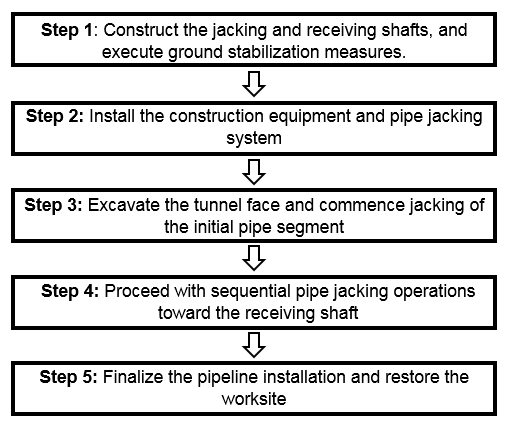Pipe jacking construction
1. Introduction
Pipe jacking is a trenchless construction method used to install underground pipelines, such as water mains, sewage systems, or gas lines. This technique utilizes high-capacity hydraulic jacks to push sections of pipe sequentially from a launching pit to a receiving pit, forming a continuous underground pipeline without requiring surface trenches. This method is particularly beneficial in urban areas where trench excavation would disrupt traffic flow and interfere with existing infrastructure.
Pipe jacking technology offers several advantages, including reduced excavation volume, resulting in lower transportation costs and minimized road restoration requirements. The method also reduces traffic congestion, minimizes environmental impact, and eliminates disturbances to nearby residents. Furthermore, pipe jacking helps to mitigate the risks of ground settlement and reduces potential impacts on surrounding infrastructure, all while significantly shortening construction time.
This technology first emerged in the United States in 1910, and by 1960, the American Pipe Jacking Association had formally established foundational principles for the method. Pipe jacking dramatically developed in Japan during the 1970s and spread across Europe in the 1980s. In Vietnam, it has been successfully employed since 2008, most notably in Phase 1 of the Water Environment Improvement Project in Ho Chi Minh City.
2. Scope of application
Due to exceptional construction advantages, the pipe jacking method is widely applied across various types of projects, including:
- Water supply and drainage systems, gas and oil pipelines, electrical cable systems, and telecommunications networks.
- Underpasses for roadways, railways, canals, rivers, and beneath buildings.
- Pedestrian tunnels and connection tunnels between larger tunnels.
3. Construction sequence
The construction sequence of pile jacking method consists of 05 main steps as illustrated in Fig. 1.

4. Technology video
REFERENCES
[1] Kevin John Ripley (1989). The Performance of Jacked Pipes. A thesis for Ph.D at the University of Oxford, pp.14-15.
[2] Tiêu chuẩn khoan kích ống ngầm Pipe Jacking. Bộ đất đai, hạ tầng, giao thông và du lịch Nhật Bản (2013).
[3] James Thomson (1993). Pipe Jacking and Micro-Tunnelling. CRC Press.
[4] François Xavier Borghi (2006). Soil conditioning for Pipe Jacking and tunnelling. A thesis for Ph.D at the University of Cambridge, pp.2-4.
[5] Shih-Yun Liu (2007). Slurry Dewatering in Pipe Jacking Industry. A thesis for Ph.D at the University of Leeds, pp.6-24.
- Foundation and Soil improvement
- Large diameter soil-cement column (RAS) construction method
- Shaft grouted bored pile construction method
- Deep vibro stone columns
- Prefabricated Vertical Drain (PVD) combined with vacuum preloading technology
- PHC piles installation by SIP machine
- Pre-bored pile (BASIC) installation
- Diaphragm wall construction
- Other technologies
- Underground Construction
- Infrastructure Construction
- Building and Plant construction



